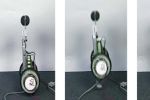Meet The Car That Can’t Crash
The latest model from Volvo can detect when you’re about to rear-end the car in front, and it automatically slams on the brakes. There’s only one catch: the system only guarantees you won’t have a fender bender if you’re travelling at less than 15km/h. It is still effective up to 30km/h, although there may be a small scrape.
The technology is so good that insurance companies are considering reducing the premiums of the car, called XC60.
It turns out low-speed rear-enders in stop-start traffic are the most common type of crash. Volvo claims that 75 per cent of all reported collisions occur below 30km/h and that, in half of those, the driver has not braked in time.
Volvo’s City Safety system uses sensors in the windscreen to detect a stationary car up to 8 metres ahead. Making 50 calculations a second, the computer determines if an impact is likely, and determines the braking force needed to avoid a collision if the driver doesn’t react in time.
We got to try City Safety in several scenarios, testing it against an inflatable car. It’s a weird sensation driving towards a car at 15km/h and being told to not touch the brakes, no matter what your instinct. Indeed, when developing the technology, Volvo had to retrain its drivers.
The system brakes much later than you normally would. This was done so it would not create lazy drivers who rely on it – which was initially a concern of authorities in Japan, who’ve since approved the car for registration there.
“It is important to underline that City Safety does not relieve the driver of the responsibility of maintaining a safe distance to avoid a collision,” says said Jonas Ekmark, manager of Preventive Safety at the Volvo Car Corporation’s Car Safety centre. “The automatic braking function does not react until it considers a collision is imminent.”
When the brakes are triggered at about 15km/h, there is still a gap wide enough to walk between once the car has stopped. We also tried it at higher speeds, working our way up to 30km/h, when it gently nudged the inflatable car. In the real world this could have been a simple case of a plastic bumper popping back into position.
We also approached the inflatable car from an offset position – that is, half of the Volvo was in the next lane, and half was behind the parked inflatable car. It was less effective in this scenario.
Volvo is already working on a new version that can also detect pedestrians. Meanwhile, BMW and Mercedes-Benz are working on systems that will be able to avoid crashing into a stationary car from 80km/h.
2 Comments
Popular Tags
Cars
Regular Features
Popular on Popsci
Most Viewed
Cars
- Headphones Behind the Wheel? You’re Joking, Right?
- Meet The Car That Can’t Crash
- Kubica-Vettel Crash Explained
- Formula 1's KERS explained
- Can Cars Float?
- Roadside Ads Distract Drivers
- Sub-$US2000 Tata Nano is Officially The World's Cheapest Car
- How to Build an F1 Car - Red Bull Style
- Flying Car Succeeds in Test Flight
Most Commented
Cars
- Meet The Car That Can’t Crash
- Sub-$US2000 Tata Nano is Officially The World's Cheapest Car
- Headphones Behind the Wheel? You’re Joking, Right?
- Can Cars Float?
- Kubica-Vettel Crash Explained
- Formula 1's KERS explained
- Roadside Ads Distract Drivers
- How to Build an F1 Car - Red Bull Style
- Flying Car Succeeds in Test Flight
Most Emailed
Cars
- Flying Car Succeeds in Test Flight
- Meet The Car That Can’t Crash
- Kubica-Vettel Crash Explained
- Formula 1's KERS explained
- Can Cars Float?
- Roadside Ads Distract Drivers
- Sub-$US2000 Tata Nano is Officially The World's Cheapest Car
- How to Build an F1 Car - Red Bull Style
- Headphones Behind the Wheel? You’re Joking, Right?









Comments
If they can work out a way to implement it for pedestrians that would be fantastic and would probably prevent a lot of accidents, especially in school zones where children occasionally just run out on the road for no reason.
It'd be pretty fun to try out though in a controlled situation like above. The temptation to use the brake would be overwhelming as it's so second nature to anyone that's been driving for more than a few weeks I think
0 out of 0 people found this comment helpfulI would love to see BMW and Mercedes version which could avoid an accident at 80km/h. Nonetheless, Volvo's design would save quite a number of those accidents which aren't too serious yet manage to dig fairly deep into your wallet. And that's something no one wants to have to deal with in this time!
Eventually, they'll surround the car with sensors to detect objects around you. You might have live feed cameras instead of wing and rear view mirrors, and eventually, you might not even be driving the car! That could be the safest measure in the end, removing the human error altogether.
0 out of 0 people found this comment helpful